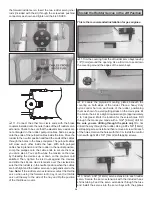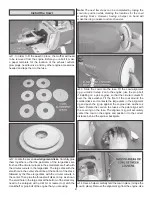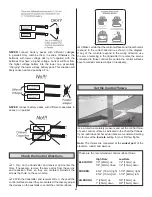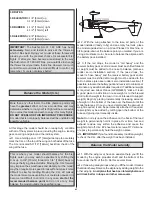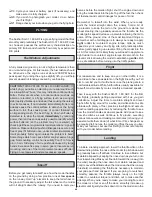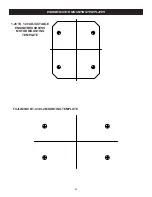
46
IMAA SAFETY CODE (excerpts)
Since the Sukhoi SU-31 1.60 ARF qualifi es as a “giant-
scale” model and is therefore eligible to fl y in IMAA
events, we’ve printed excerpts from the IMAA Safety
Code which follows.
What is Giant-Scale?
The concept of large or giant-scale is generally considered to
apply to radio controlled model aircraft with minimum wingspans
of 80 inches for monoplanes and 60 inches for multi-wing aircraft.
Quarter-scale or larger replicas of person-carrying aircraft with
proper documentation (minimum 3-view drawing) which do not
fi t the size requirements will also be permitted.
SECTION 1.0: SAFETY STANDARD
1.1 Adherence to Code: The purpose of this Safety Code
is to provide a structure whereby all participants, including
spectators, will be aware of the inherent dangers in the
operation of radio controlled aircraft. This code is meant
to serve as a minimum guideline to all participants. It is
understood that the ultimate responsibility for the safety of
any aircraft lies with the owner(s), pilot(s) and spectator(s)
involved in any event. It is the responsibility of all participants
to exercise caution when operating, or observing the
operation of all radio controlled aircraft. The pilot/owner of
an aircraft will not be dissuaded from taking whatever steps
they deem necessary, in addition to this code, to insure that
their aircraft is safe.
1.2 The most current AMA Safety Code in effect is to
be observed.
SECTION 3.0: SAFETY REVIEW
3.4 Flight Testing: All giant-scale aircraft are to have been fl ight
tested and fl ight trimmed with a minimum of six (6) fl ights before
the model is allowed to fl y at an IMAA Sanctioned event.
3.5 Proof of Flight: The completing and signing of the
Declaration section of the Safety Review form (see Section
3.2) by the pilot (or owner) shall document, as fact, that the
noted aircraft has been successfully fl ight tested and proven
airworthy prior to the IMAA event.
SECTION 4.0: SPOTTER/HELPER
4.1 Spotter/Helper Defi nition: An assistant to aid the pilot
during start-up and taxing onto the runway. The spotter/
helper will assist the pilot in completing a safe fl ight.
4.2 Each pilot is required to have a spotter/helper at all IMAA
sanctioned events. The event Safety Committee should be
prepared to assist those pilots who do not have a spotter/
helper to make sure that every registered pilot has the
opportunity to fl y at a sanctioned event.
SECTION 5.0: EMERGENCY ENGINE SHUT OFF (kill switch)
5.1 All magneto spark ignition engines must have a coil-
grounding switch on the aircraft to stop the engine. This will
also prevent accidental starting of the engine. This switch
shall be readily available to both pilot and spotter/helper.
This switch is to be operated manually and without the use
of the radio system.
5.2 Engines with battery powered ignition systems must
have a switch to turn off the power from the battery pack to
disable the engine from fi ring. This will also prevent accidental
starting of the engine. This switch shall be readily available
to both pilot and spotter/helper. This switch shall be operated
manually and without the use of the radio system.
5.3 There must also be a means to stop the engine from
the transmitter. The most common method is to completely
close the carburetor throat using throttle trim, however other
methods are acceptable. This requirement applies to all
glow/gas ignition engines regardless of size.
SECTION 6.0: RADIO REQUIREMENTS
6.1 All transmitters must be FCC type certifi ed.
6.2 FCC Technician or higher-class license required for 6 meter
band operation only.
Additional IMAA General Recommendations
The following recommendations are included in the Safety
Code not to police such items, but rather to offer basic
suggestions for enhanced safety. It is expected that IMAA
members will avail themselves of technological advances as
such become available, to promote the safety of all aircraft
and participants.
Servos need to be of a rating capable to handle the loads
that the control surfaces impose upon the servos. Standard
servos are not recommended for control surfaces. Servos
should be rated heavy-duty ounces of torque. For fl ight-critical
control functions a minimum of 45 inch/ounces of torque
should be considered. This should be considered a minimum
for smaller aircraft and higher torque servos are strongly
encouraged for larger aircraft. The use of one servo for each
aileron and one for each stab half is strongly recommended.
Use of dual servos is also recommended on larger aircraft.
On-board batteries should be, at a minimum, 1000mAh up
to 20 lbs., 1200mAh to 30 lbs., 1800mAh to 40 lbs., and
2000mAh over 40 lbs. fl ying weight. The number and size
of servos, size and loads on control surfaces and added
features should be considered as an increase to these
minimums. Batteries should be able to sustain power to the
on-board radio components for a minimum of one hour total
fl ying time before recharging.
Dependable, redundant and fail-safe battery systems
are recommended.
Summary of Contents for GPMA1412
Page 52: ......



